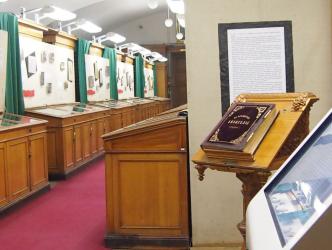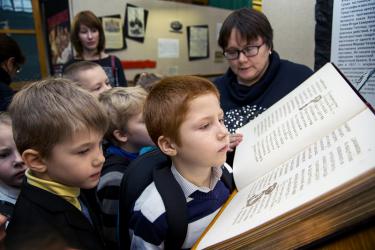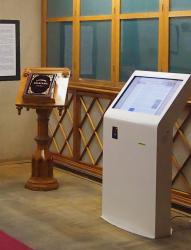21nd Century: New Information Technologies
During the same period, the Eastern stocks have been replenished with three hundred manuscripts in Oriental languages, drawings, and xylographs. A third of them are part of the collections assembled by Academician I. Steblin-Kamensky, S. Khanukaev, and S. Rasulov. These collections, with few exceptions, consist of Muslim manuscripts. In recent years, the vast majority of acquisitions are Arabographic books. It is very interesting that even now it is possible to purchase ancient (starting with the 14th century) and rare, from an artistic point of view, manuscript books decorated with miniatures and ornaments.
Noteworthy are the West European handwritten materials related to the new time, received by the department. Among them, for instance, are Prosper Merimer's autograph quatrain Mother Russia, written in Russian on his own pen drawing (1850s), and the small collection of Roger Lewis (1884– after 1928), an American journalist, a member of the American Red Cross mission in Russia.
From the outset, the Manuscripts Department was not only a repository for collecting early literature, but also a center for the study of manuscripts. This tradition was founded by three eminent scholars: the Russian paleographer A. Ermolaev, who taught the famous historian Nikolay Karamzin the intricacies of this science; one of the first Russian philologists, expert on the Church Slavonic manuscripts Alexander Vostokov and Afanasy Bychkov, a compiler of exemplary inventory of Church Slavonic and Russian manuscripts. The laborious task of description of ancient writings and cataloging manuscripts collections were continued by archaeographers, historians and literary researchers Kh. Loparev, I. Bichkov, D. Abramovich. Over two centuries, the department has formed research sectors on Slavic, Greek, Eastern and Western European manuscript studies. The Department hosts annual conferences as well as numerous symposia and cultural and educational events on exploring and promoting cultural heritage.The department's staff still follow the rules established in the first library laws of 1810–1812. These documents define the "structure and content" of the Library and the main areas of responsibility of the Manuscripts Department, including the preservation of handwritten heritage on condition of "receiving visitors and providing all the necessary information to them".
During the modern Internet era, the library seeks new ways to provide information on its richest manuscript stocks. The National Library's specialists have created the Depository information retrieval system as a new instrument to facilitate our staff's work in all fields, such as reference and bibliographic, scientific and publishing activities. It was used to produce the electronic database and electronic catalogue of the Manuscripts Department. In addition, All interested people may access digitised landmark manuscripts.
The handwritten landmarks – the great human treasure - should have a more prominent place on the Internet and become an essential element in creating a socio-cultural environment. The web-site of the Manuscripts Department is designed to solve this question.


